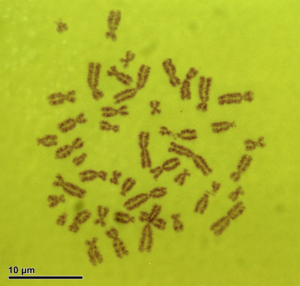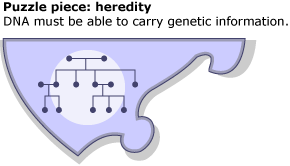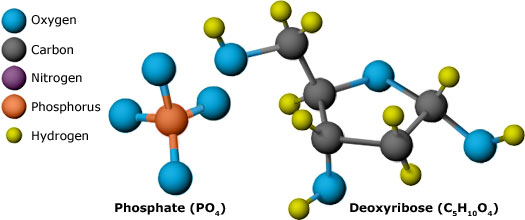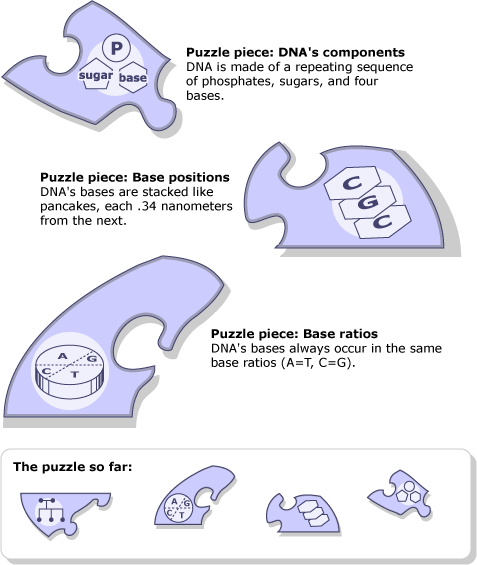Scientific discoveries may seem like sudden breakthroughs — the work of a genius who just “sees” the answer — but new findings don’t come out of nowhere. Each breakthrough is made possible by the work that came before it. Some scientific discoveries are a bit like putting together the pieces of a puzzle. Many different researchers discover important bits of evidence — pieces of the puzzle — and the sudden breakthrough arises when one group or person sees how the puzzle pieces logically fit together. And sometimes — as in the case of DNA — new findings and technological advances have made so many new puzzle pieces available that the odds of someone putting them together seem quite high. Making this final leap often involves a brilliant insight — but it’s important to recognize all the clues which made that insight possible.
In the 19th century, the Austrian monk, Gregor Mendel, discovered basic patterns of inheritance. Traits pass from parent to offspring in an organized and predictable way. Although the scientists that followed in Mendel’s footsteps had no concrete understanding of what caused these distinct patterns, they knew that the explanation of inheritance would have to account for them.

By the 1940s and 50s, scientists were getting closer to a physical explanation of how parents pass on traits to their offspring. New technology had made it possible to observe smaller structures than ever before. Biologists had found that genetic instructions are carried on parts of the cell known as chromosomes, and chemists had discovered that these chromosomes are made up of two components: proteins and DNA. Furthermore, experiments looking for the key molecule of life had zeroed in on DNA, and not protein, as the component that actually carries genetic information.
 But exactly how could DNA carry all the information needed to make a new organism? The answer might be revealed by the molecule’s three-dimensional structure — and some tantalizing clues regarding this structure were becoming available. Researchers already knew that DNA was a relatively simple molecule. It seemed to consist of an unremarkable chain of phosphates and sugars, in some way attached to a set of ring-shaped molecules called nitrogenous bases. These bases come in four “flavors”: adenine (A), thymine (T), cytosine (C), and guanine (G). Somehow, these simple components would have to carry all the instructions necessary to make fruit flies, oak trees, humans, and the rest of life. Some early work suggested that the bases were arranged like a stack of pancakes in the molecule, each .34 nanometers apart from one another,1 but other than that, little was known about exactly how a DNA molecule was put together.
But exactly how could DNA carry all the information needed to make a new organism? The answer might be revealed by the molecule’s three-dimensional structure — and some tantalizing clues regarding this structure were becoming available. Researchers already knew that DNA was a relatively simple molecule. It seemed to consist of an unremarkable chain of phosphates and sugars, in some way attached to a set of ring-shaped molecules called nitrogenous bases. These bases come in four “flavors”: adenine (A), thymine (T), cytosine (C), and guanine (G). Somehow, these simple components would have to carry all the instructions necessary to make fruit flies, oak trees, humans, and the rest of life. Some early work suggested that the bases were arranged like a stack of pancakes in the molecule, each .34 nanometers apart from one another,1 but other than that, little was known about exactly how a DNA molecule was put together.


To further complicate matters, researchers had discovered another intriguing — but perplexing — clue. DNA’s bases always occur in the same special ratios: the amount of A is always equal to the amount of T, and C is always equal to G — though the ratio of A/T to C/G varies from species to species.2 What this meant wasn’t clear, but any hypothesis about DNA’s three-dimensional structure would have to account for this strange observation.

Around the same time that these three puzzle pieces were discovered, more and more physicists and chemists were becoming interested in applying their knowledge and skills to learning about the physical basis for life. To add further fuel to the fire, technological breakthroughs and refinements had recently offered scientists new ways to study the positions of atoms within molecular structures. Together, these factors were providing scientists with the tools and insights to put the DNA puzzle together. The stage was set for a breakthrough.
Most ideas in science are informed by multiple lines of evidence, and the structure of DNA was no exception. Clues from observations of heredity, biology experiments, chemistry experiments, and much more all factored into the investigation. To learn more about multiple lines of evidence in science, visit Competing ideas: A perfect fit for the evidence.
1Astbury, W.T. 1939. X-ray study of thymonucleic acid. Nature 141(3573):747-748.
2Chargaff, E. 1950. Chemical specificity of nucleic acids and mechanism of their enzymatic degradation. Experientia 6(6):201-209.
